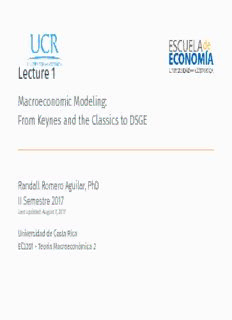
Lecture 1 - Macroeconomic Modeling: From Keynes and the Classics to DSGE PDF
Preview Lecture 1 - Macroeconomic Modeling: From Keynes and the Classics to DSGE
Lecture 1 Macroeconomic Modeling: From Keynes and the Classics to DSGE RandallRomeroAguilar,PhD IISemestre2017 Lastupdated:August7,2017 UniversidaddeCostaRica EC3201-TeoríaMacroeconómica2 Table of contents 1. Introduction 2. The Classical model 3. The Keynesian model 4. The Neoclassical Synthesis 5. The Rational Expectations Critique 6. Lucas and rational expectations 7. DSGE, RBC, New Keynesian Introduction Macroeconomics: work in progress Macroeconomics is not an exact science but an applied one where ideas, theories, and models are constantly evaluated against the facts, and often modified or rejected…Macroeconomics is thus the result of a sustained process of construction, of an interaction between ideas and events. What macroeconomists believe today is the result of an evolutionary process in which they have eliminated those ideas that failed and kept those that appear to explain reality well. Blanchard1997 1 Same objectives, different approaches There is wide agreement about the major goals of economic policy: high employment, stable prices, and rapid growth. There is less agreement that these goals are mutually compatible or, among those who regard them as incompatible, about the terms at which they can and should be substituted for one another. There is least agreement about the role that various instruments of policy can and should play in achieving the several goals. Friedman1968 2 Macroeconomics controversy One view and school of thought, associated with Keynes, Keynesians and new Keynesians, is that the private economy is subject to co-ordination failures that can produce excessive levels of unemployment and excessive fluctuations in real activity. The other view,attributedtoclassicaleconomists,andespoused by monetarists and equilibrium business cycle theorists,isthattheprivateeconomyreachesasgood anequilibriumasispossiblegivengovernmentpolicy. Fischer1988 3 Keynesian perspective Involuntary unemployment can exist and, without government assistance, any adjustment toward “full employment” is likely to be slow and to involve cycles and overshoots, either because • the economy has multiple equilibria, only one of which involves full employment; • there is only one equilibrium, but the economic system is unstable without policy. 4 Keynesians vs the Classics To this day, controversies remain active between Keynesians and those who favor a Classical approach. A major source of contention: flexible vs fixed prices and wages. 1936 Keynes publishes The General Theory 1950s NeoclassicalSynthesis: nominalrigiditiesareonly temporary 1970s Micro-foundations and the role of expectations 1980s New Classical approach: market clearing approach with no appeal to sticky prices 5 Criteria to evaluate macro models Empiricaltests: Arepredictionsconsistentwithactual experience? Unfortunately, empirical tests are often not definitive. Microfoundations: Aremodelconsistentwiththehypothesis ofconstrainedmaximization? It is utility and production functions that are independent of government policy; agents’ decision rules do not necessarily remain invariant to shifts in policy. 6 Two stages to making macro models 1. Derive the structural equations, which define the macro model, by presenting a set of constrained maximization exercises 2. Use the set of structural equations to derive the solution or reduce-form equations and perform the counterfactual exercises. Since the 1970s, the two stages are considered simultaneously: structural equations make reference to the properties of the overall system (e.g. rational expectations). 7
Description: